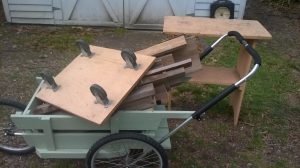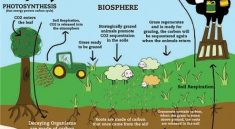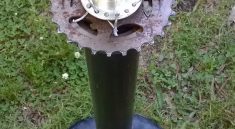Curb disposed lumber used for raised bed, Zero cost project, Penn State study “Environmental soil issues: garden use of treated lumber”
Granny says: “Waste not want not.”
I constructed a raised garden bed frame from curb disposed lumber salvaged a few days ago.
I first used my chop saw to produce 2 sets of equal length boards.
I then drilled 2 holes on each end of the longer boards large enough for the screws to easily pass through.
Doing this will cause the screws to pull the other board to tight.
Lumber salvaged from curb.

Be aware that there is treated and untreated lumber and that the treated lumber may contain harmful chemicals.
Penn State has provided an excellent explanation:
“Environmental Soil Issues: Garden Use of Treated Lumber
“Update on CCA-Treated Lumber
On February 12, 2002, the Environmental Protection Agency (EPA) announced a voluntary decision by the wood preserving industry to phase out the use of wood preservatives that contain arsenic for any wood products destined for consumer use. The phaseout is to be completed by December 31, 2003.
This transition affects virtually all residential uses of wood treated with chromated copper arsenate, also known as CCA, including wood used in play structures, decks, picnic tables, landscaping timbers, residential fencing, patios, and walkways/boardwalks. By January 2004, the EPA will not allow CCA products for any of these residential uses.
The EPA has not concluded that there is unreasonable risk to the public from CCA lumber, but believes that any reduction in exposure to arsenic is desirable. More information on this action can be found on the EPA Web site.”
“Virtually all treated wood available in retail outlets for use by the general public is preserved with inorganic chemicals, most commonly with CCA. Copper (Cu) is an effective fungicide, arsenic (As) is an effective insecticide, and chromium (Cr) serves to bind the chemical preservative to the wood. The treatment process usually involves immersing wood in a 2–3% solution of CCA and subjecting it to high pressure, which encourages deep penetration of CCA into the wood. Up to 50 gallons of CCA solution is used per cubic yard of wood. The treated wood has concentrations of Cr, Cu, and As that range from 1000 to 5000 mg/kg (parts per million). Wood treated by this method is also known as “pressure-treated lumber” and by the trade name “Wolmanized.” The CCA method of wood preservation is popular because it is effective, and because wood treated with CCA can be painted and has no objectionable odors.”
Read more:
http://extension.psu.edu/plants/crops/esi/treated-lumber




